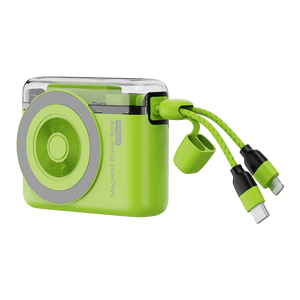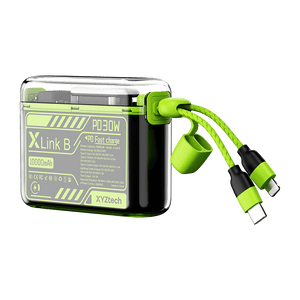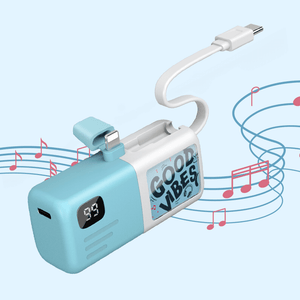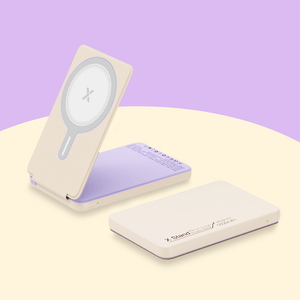Best Power Banks for Backpacking: Top 5 Adventure-Ready Picks
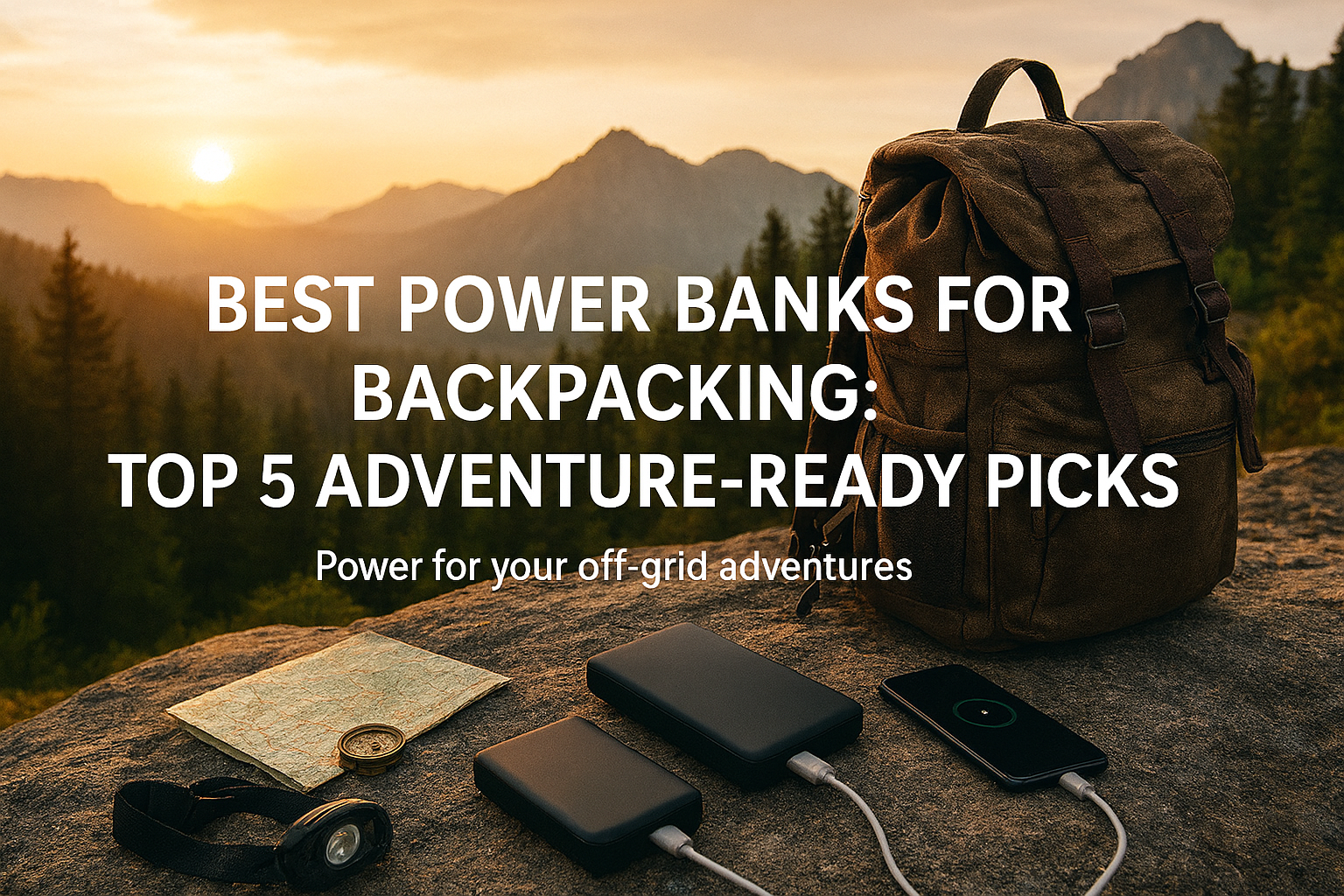
When you’re miles from the nearest outlet, your phone isn’t just a phone — it’s your map, your camera, your flashlight, and sometimes your lifeline. With so many different types of power banks on the market, finding the best backpacking power bank for your needs is a crucial piece of gear planning. You need a device that's built for the trail, not just the coffee shop.
That’s where a good power bank earns its keep. But finding the right one among the best power banks for backpacking? That’s the tricky part. Some are heavy bricks, others barely hold a charge, and a few seem allergic to dirt and weather. The goal is simple: get something that’s powerful enough to last, light enough to carry, and reliable enough to trust — every time.
We’ve rounded up five of the best 10,000mAh power banks built for backpackers who want that perfect balance between strength and portability. From the ultralight Nitecore NB10000 Gen 3 to the feature-rich XYZtech X Link A 10K, here’s how the top contenders stack up when adventure calls.
Let’s get started!
The Backpacker’s Dilemma: Capacity vs. Weight vs. Features
The backpacking community lives by a holy trinity of conflicting requirements: Capacity, Weight, and Features.
For years, finding a power bank that satisfied all three felt like chasing a mythical beast. You could find a gigantic, rugged bank that could power a small village, but it weighed as much as a full water bottle (massive weight penalty). Alternatively, you could find one lighter than a bag of trail mix, but it wouldn't even manage a single full charge on your smartphone (capacity failure). And then, if you found one with decent capacity and low weight, it often lacked the outdoor-specific features—like water resistance, a built-in light, or the sheer durability to survive a tumble off a granite slab.
This struggle is the heart of the matter. Backpackers need a power bank that:
- Hits the "Sweet Spot" Capacity: For a 3-5 day trip, 10,000 mAh is the consensus sweet spot. It offers 2-3 full smartphone charges—enough to power a phone in airplane mode, a headlamp, and a GPS watch.
- Is Featherlight: Ultralight hikers are militant about weight. Every ounce added to a pack is energy burned on the trail, which is why brands are pushing the limits of materials like carbon fiber.
- Is Trail-Ready: It needs to handle rain, dust, temperature fluctuations, and accidental drops. Bonus points for integrated cables or features that reduce other items you need to carry.
We have scoured the market and compared the best 10,000 mAh-class power banks for the trail today. Our goal is to help you cut through the noise and identify the best portable power bank for backpacking for your specific needs. Let's dive into the top five adventure-ready picks.
Top 5 Best Power Banks for Backpacking: Adventure-Ready Picks
1. The Ultralight King: Nitecore NB10000 Gen 3
Price: $64.95
Capacity: 10,000 mAh
Weight: 150 g
Size: 122 x 59 x 11
Material: Carbon fiber reinforced polymer
Output: USB-C (22.5W Max) | Dual (15W Max)
Charging Time: ~2.5 hours
Colors: Black

Image via Nitecore
Nitecore, a brand beloved by hardcore outdoor enthusiasts for its high-performance flashlights, has completely dominated the ultralight power bank market. The NB10000 Gen 3 is a testament to minimalist engineering, achieving the seemingly impossible: a full 10,000 mAh capacity in a package that weighs almost nothing. For gram-counters who refuse to compromise on performance, it consistently ranks among the best power banks for backpacking available today.
Why it Wins for Backpacking
- The reason the Nitecore NB10000 Gen 3 is legendary on the trail is simple: weight. At a shocking $150 (about $5.3 ounces), this power bank weighs less than most modern smartphones and is significantly lighter than anything else in the 10K mAh category. This feat is accomplished through its construction using a highly durable, lightweight carbon fiber composite shell, typically reserved for high-performance racing gear.
- Beyond the low weight, it offers great charging specs with a 22.5W max output from its USB-C port, allowing it to rapidly charge modern phones and even quickly top off a small tablet. It is also IPX5-rated, meaning it can withstand jets of water, so a sudden downpour or an accidental splash won't kill your power source. Despite its ultralight build, its tough shell and water resistance make it a genuinely rugged power bank that can handle the rigors of the trail. It even includes a low-current mode for safely charging small electronics like Bluetooth headphones and GPS watches, a feature critical for maintaining the lifespan of specialized gear.
|
Pros |
Cons |
|
👍 World-Class Ultralight Design: The lightest 10K power bank available. 👍 Carbon Fiber Build: Excellent durability-to-weight ratio. 👍 IPX5 Water Resistance: Built to handle the elements. 👍 22.5W Fast Charging: Quick power delivery for modern devices. |
👎 High-end price point ($64.95) reflecting its premium, specialized build. 👎 Requires you to carry your own charging cables. 👎 Dual port charging is limited to a combined 15W. 👎 No integrated safety features like a flashlight or wireless charging. |
2. The Feature-Packed Hub: XYZtech X Link A 10K
Price: $39.99
Capacity: 10,000 mAh
Weight: 265 g
Size: 87 x 67 x 28 mm
Material: ABS fire-proof clear plastic shell
Output: USB-C 25W Max | Lightning 20W Max | Wireless 15W Max
Charging Time: 2–3 hours
Colors: Green, Orange, Cream

Image via XYZtech
The XYZtech X Link A 10K enters the field not as a minimalist, but as a maxed-out multi-tool. While it sits at a slightly heavier weight compared to the carbon fiber elite, it packs in a comprehensive suite of features designed to eliminate the need for other gear you'd otherwise have to carry.
Why it Wins for Backpacking
- What makes the X Link A 10K stand out is its extraordinary versatility and convenience, especially for Apple users. It features built-in USB-C and Lightning cables, solving the perennial problem of forgetting a cable at home or having one get tangled and damaged in your pack. The inclusion of MagSafe compatibility means you can simply snap your iPhone onto the back for wireless charging, a huge convenience around camp when you want to use your phone while it charges without fumbling with cables.
- The power bank also boasts impressive safety features, including NTC temperature control to prevent overheating—essential when charging devices inside a hot tent or pocket. With a 25W max USB-C output, it’s the fastest charger on this list, offering premium charge speeds. Furthermore, the inclusion of a bright built-in LED flashlight gives you a secondary emergency light source, saving you weight by leaving a backup miniature light at home. All this, while keeping the price highly competitive at $39.99, establishes it as a robust, quality option that directly competes with the market leaders.
|
Pros |
Cons |
|
👍 Integrated Dual Cables: Never forget your cables (USB-C & Lightning). 👍 25W Max Output: The fastest power delivery speed in this group. 👍 MagSafe Wireless Charging & LED Flashlight: Excellent utility and feature density. 👍 Great Value: Feature-rich package for a competitive price ($39.99) |
👎 Heavier at 265g than the Nitecore and Goal Zero options. 👎 Wireless charging features may be superfluous for ultralight hikers. 👎 ABS fireproof plastic is durable, but not as inherently rugged as a carbon fiber or IPX7-rated shell. |
3. The Compact Speedster: Zendure Super Mini 10000
Price: $39.99
Capacity: 10,000 mAh
Weight: 180 g
Size: 79 × 56 × 26 mm
Material: Aluminum/metal shell
Output: USB-C PD (18W)
Charging Time: ~3 hours
Colors: Blue, Red, Green, Purple, Pink

Image via Zendure
The Zendure Super Mini 10000 is for the hiker who appreciates a high-quality feel and minimal footprint. It prioritizes compact size and rapid recharge performance, meaning less waiting time both on and off the trail. For those who value a sleek, pocketable design without sacrificing power, this is a strong contender for the best backpacking portable charger in its class.
Why it Wins for Backpacking
- Zendure built the Super Mini using advanced 21700 battery cells, which are known for being 50% more energy-dense than traditional cells. This allows them to create a full 10,000 mAh capacity bank that is approximately 30% smaller than traditional models, earning its "credit card size" description. While we estimate its weight to be around 180 grams, its small dimensions make it exceptionally pocket-friendly.
- It also boasts an 18W USB-C PD output, providing fast charging for a variety of devices. The major benefit for the trail is its incredibly fast 3-hour recharge time when plugged into an 18W charger. If you manage to find a plug-in point or use a robust solar panel during the day, you can fully replenish your power bank quickly. The dedicated X-Charge Mode also ensures you can safely charge low-power accessories like fitness trackers or small headlamps.
|
Pros |
Cons |
|
👍 Ultra-Compact Size: Credit-card-sized footprint, fits anywhere. 👍 Rapid 3-Hour Recharge: Minimal downtime when you find power. 👍 18W Power Delivery: Good charging speed for size. |
👎 Requires you to carry separate charging cables. 👎 Less focus on outdoor durability features (no IP rating found). 👎 No integrated utility features (flashlight, etc.). |
4. The Reliable Budget Pick: Anker 313 Power Bank (PowerCore 10K)
Price: $25.99
Capacity: 10,000 mAh
Weight: 236 g
Size: 149 x 68 x 14 mm
Material: Standard plastic shell
Output: USB-A (12W Max) | USB-C (15W Max input/output)
Charging Time: ~4.5 hours
Colors: Black, White

Image via Anker
When reliability and budget are your main concerns, Anker is the brand that consistently delivers. The Anker 313 (PowerCore 10K) is a foundational piece of tech—it is a dependable, no-frills workhorse. While it may not have the flashiest specs, its proven track record makes it a strong candidate for the best backpacking power bank for those on a tight budget.
Why it Wins for Backpacking
- The Anker 313 is the undisputed budget champion on this list, often retailing for just $25.99. For backpackers looking for a dependable 10,000 mAh of charge capacity without breaking the bank, this is the default choice.
- Anker’s reputation is built on its power bank safety and smart charging features, including its Superior Safety system with surge protection and short-circuit prevention—giving you peace of mind in any environment. Its slim size and modest weight of 7.5 ounces (approx. 213g) keep it competitive on the trail. It’s an honest piece of gear: it provides the advertised capacity and reliable power to your devices, thanks to its proprietary PowerIQ technology. It also includes a Trickle-Charging Mode for delicate electronics. If you’re a first-time power bank buyer or a repeat buyer who just needs a solid, secondary bank, the 313 offers an incredible value proposition that’s hard to beat.
|
Pros |
Cons |
|
👍 Unbeatable Value: Extremely affordable at $25.99. 👍 Known Reliability: Backed by Anker’s excellent reputation and safety features. 👍 Slim Design: Easy to slide into a pocket or pack sleeve. 👍 Max Output is 15W (Note: some specifications list this as 12W or 5V 2.4A max output). |
👎 Slower charging compared to the 18W and 25W options. 👎 Slower recharge time due to 10W max input. 👎 Uses an older Micro-USB input port alongside USB-C, which is less convenient. |
5. The Solar-Ready Companion: Goal Zero Flip 36
Price: $39.95
Capacity: 9,600 mAh
Weight: 193 g
Size: 94 x 61 x 21
Material: Standard plastic shell; rugged outdoor design
Output: USB-A (10.5W Max)
Charging Time: ~5 hours (USB), compatible with solar panels
Colors: Black, Slate Blue, GZ Green

Image via Goal Zero
Goal Zero is synonymous with off-grid power, and the Flip 36 is their compact entry. While technically 9,600 mAh, it fits squarely into the 10K class and is perfectly integrated into the world of solar charging. For adventurers building a solar-powered kit, this could easily be the best battery pack for backpacking due to its seamless ecosystem integration.
Why it Wins for Backpacking
- The Goal Zero Flip 36's greatest strength is its seamless integration with the Goal Zero ecosystem. It is explicitly "Solar Ready" and optimized to pair with their Nomad series of portable solar panels. For a backpacker on a long-distance trail, the ability to harvest solar power and pass it directly into the power bank is a major advantage.
- Its most unique feature is the integrated, flip-out USB-A plug for recharging. This eliminates the need for a separate input cable (though it does require a USB wall adapter or solar panel with a standard USB port), making charging simpler when you find an outlet. At 193 grams (6.8 oz), it’s one of the lighter options available, and its physical dimensions are the most compact of the group. It is designed for simple, reliable power delivery on the go.
|
Pros |
Cons |
|
👍 Integrated Flip-Out USB-A Plug: Easy to recharge from any USB port without a cable. 👍 Solar Ready: Optimized for use with Goal Zero Nomad solar panels. 👍 Very Light and Compact: Only 193g (6.8oz) |
👎 Lowest Output: Only 10.5W max output, the slowest charger on the list. 👎 Lowest Capacity (9,600mAh) 👎 Customer reviews indicate potential long-term durability issues with the flip-out plug. |
The Best Backpacking Power Bank: Side-by-Side Comparison
Here’s a quick rundown table of how our five adventure-ready picks stack up.
|
Model |
Price |
Capacity |
Weight |
Size |
Material |
Output |
Charging Time |
Colors |
|
Nitecore NB10000 Gen 3 |
$64.95 |
10,000 mAh |
150g |
122.0 × 59.2 × 10.6 mm (4.80" × 2.33" × 0.42") |
Carbon fiber composite (carbon-fibre reinforced polymer) with anti-torsion structure |
USB-C dual ports; output up to ~22.5W max (10V-2.25A) |
~2.5 hours |
Black |
|
XYZtech X Link A 10K |
$39.99 |
10,000 mAh |
265g |
87 x 67 x 28 mm |
ABS fire-proof clear plastic shell |
USB-C output 25W (10V-2.5A) + Lightning output 20W (9V-2.22A) + Wireless up to 15W (5/7.5/10/15) |
2–3 hours |
Green, Orange, Cream |
|
Zendure SuperMini 10000 |
$39.99 |
10,000 mAh |
180g |
3.1 × 2.2 × 1 in (~79 × 56 × 26 mm) |
Aluminium/metal shell (or premium casing) |
USB-C PD (18W) |
~3 hours |
Blue, Red, Green, Purple, Pink |
|
Anker 313 Power Bank (PowerCore 10K) |
$25.99 |
10,000 mAh |
236g |
5.87 x 2.68 x 0.55 in (≈ 149 x 68 x 14 mm) |
Standard plastic shell |
USB-A (12W Max) / USB-C (15W Max input/output) |
~4.5 hours |
Black, White |
|
Goal Zero Flip 36 |
$39.95 |
9,600 mAh |
193g |
3.7 × 2.4 × 0.83 in (~94 × 61 × 21 mm) |
Standard plastic shell; rugged outdoor design |
USB-A output up to 10.5W (5V/2.1A) |
~5 hours (USB), compatible with solar panels |
Black, Slate Blue, GZ Green |
Final Thoughts: Which Adventure-Ready Power Bank is for You?
So, after all that, which of the best power banks for backpacking should you strap to your pack? It all comes down to your personal priorities on the trail.
- If your top priority is saving every single gram: The Nitecore NB10000 Gen 3 is your undisputed champion. Pay the premium and enjoy the lightest load.
- If you want the best balance of features, convenience, and price: The XYZtech X Link A 10K is a phenomenal choice. The built-in cables, wireless charging, and digital display solve so many minor trail headaches, and its price is very reasonable for what you get. Its exceptional 1000-cycle lifespan also makes it a smart long-term investment.
- If you're on a super tight budget: The Anker 313 will get the job done reliably, just be prepared for slower charging and an extra cable.
- If cable-free wall charging is your dream: The Goal Zero Flip 36 is uniquely suited for your needs, especially if you’re more of a car camper than a thru-hiker.
- If you value a slim, stylish design with fast charging: The Zendure SuperMini is a sleek and powerful companion for the urban adventurer.
For most backpackers seeking the best backpacking power bank, the sweet spot lies in a power bank that doesn’t force you to make too many compromises. The XYZtech X Link A 10K stands out by offering a compelling mix of the critical features you’ll actually use—fast charging, no-forgotten-cables peace of mind, a handy flashlight, and the bonus of wireless/MagSafe charging—all while maintaining a respectable weight and a very competitive price. It’s a thoughtfully designed piece of gear that understands the nuanced needs of a modern backpacker, proving that the best power bank for the trail isn’t always the lightest or the cheapest, but often the smartest.
No matter which you choose, you’ll be taking a step towards never missing that sunset photo or losing your navigation again. Happy trails, and may your battery percentage ever be high!
Frequently Asked Questions
Q: Are solar power banks better for backpacking?
Not necessarily. Built-in solar panels charge very slowly, especially under partial sunlight. It’s usually better to pair a regular power bank with a separate, efficient foldable solar panel if you plan long off-grid trips.
Q: How do I keep my power bank from draining too fast in cold weather?
Keep it close to your body or inside an insulated pouch when temperatures drop. Cold slows down battery performance, but warming it slightly before use helps maintain capacity.
Q: What’s the safest way to charge my devices outdoors?
Avoid charging under direct rain or in wet environments. Use short, high-quality cables and charge devices in a dry shelter or inside your pack’s pocket to prevent moisture damage.


